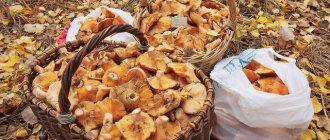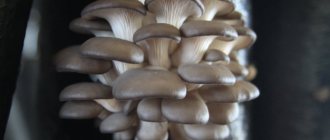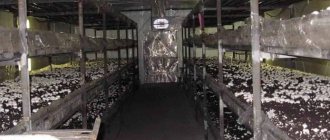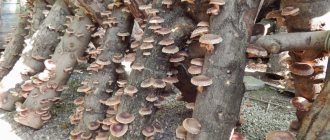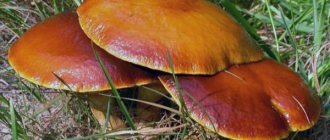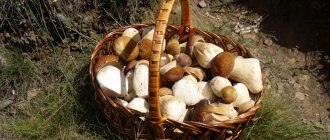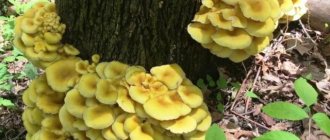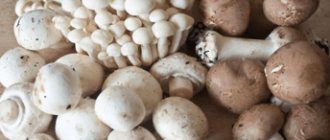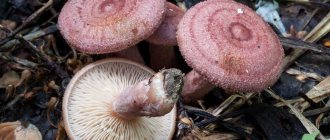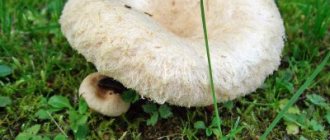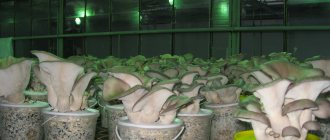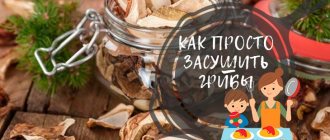Reading time: 19 minutes
1
Thanks for the article
Growing mushrooms in your dacha will be successful if you select a suitable location and provide conditions that are as close to natural as possible. For the most part, mycelium grows in tandem with tree roots, to which the mycelium gives minerals and antibiotics, receiving amino acids and carbohydrates in return.
What mushrooms can you grow in your garden?
If you follow all the rules of cultivation, then in 2-5 years from one mycelium you can get a harvest of up to 2 kg per 1 square meter. So, what mushrooms can you grow in your garden?
Oyster mushrooms. They can be grown in beds using a special substrate, or on the stumps of deciduous trees. Care consists mainly of regular watering.
Boletuses. The plantation can be set up next to the spruce or pine tree that grows in the country. In addition, a place near wooden buildings or storage of wood of these species is suitable.
Champignon. Shaded areas of the garden are prepared for mushroom beds - they are filled with compost with mushroom mycelium. Champignons need to be constantly watered and protected from temperature changes.
Chanterelles. The key to success in this case is the correct preparation of the mycelium, its transportation from the forest and the storage period before planting. In the case of established mycelium, the first harvest can be harvested within 2-3 years.
Honey mushrooms. The basis for their cultivation is stumps of deciduous trees. Small holes are drilled into them, which are subsequently filled with mycelium. In order for the mycelium to germinate and begin to bear fruit, the tree must be constantly moistened.
White mushrooms. They can be grown under trees that grow in the country (spruce, beech, oak, birch). It is best to move the mycelium to an area from the forest. But it is important that the type of wood in the dacha and in the forest matches.
On a note ! There are different ways to grow mushrooms in the country. Moreover, they are used both for obtaining planting material and directly for harvesting.
Landing
Growing forest soil mushrooms in a summer cottage begins with selecting a convenient location. In the middle there is a symbiont tree. You can plant in a circle with a radius of one and a half meters around the trunk.
You need to pour the infusion with spores, prepared yourself, on the bottom of the plot - you will need about two liters per “square” of land. Mushroom cake is poured on top. If planting is carried out from purchased seeds for cultivation, 25 g of seed is mixed with a liter of clean sand, placed on the bottom of the hole and covered with soil mixture.
If the mycelium was taken from the forest, preliminary soil preparation will be required:
- At a distance of half a meter from the selected tree, you will need to remove a layer of earth 30 cm thick.
- Line the bottom of the pit with fallen leaves, straw and sawdust.
- Sprinkle with soil, on which to place the harvested forest mycelium.
- After planting, pour water and cover with fallen leaves.
- During the first two to three weeks during severe drought, it is necessary to water the ridge generously.
If forest dwellers were planted in open soil in the fall, then the harvest is planned approximately in a year. During the period of winter cold, the ridge must be insulated by covering it with spruce branches or dry fallen leaves.
To obtain champignons grown in open ground, a plot with beds is arranged under a canopy or in the shade of large trees. The compost is applied directly to the garden soil, the height of the bed is about 25 cm.
The planting method depends on the type of mycelium. If a method is chosen, such as growing mushrooms from seeds, the grain mycelium is scattered over the compost layer and covered with a substrate. The thickness of the coating is at least four centimeters. Planting of compost mycelium is carried out by analogy with plant crops - in holes staggered at a distance of a quarter of a meter.
You can grow a mushroom colony together with shade-loving garden plants, such as cucumbers or zucchini. You will need to stretch the film over the beds. First you need to plant the seedlings, and only then the mycelium.
If desired, grow champignons at the dacha in boxes or bags, placing the plant under a canopy under the protection of tree crowns.
Varieties growing on trees are bred in bags, high boxes, on logs and stumps. Planting in bags or other containers is carried out as follows:
- Planting material and nutrient mixture are mixed on the table and then placed in bags. Or fill the container in layers - five centimeters of soil mixture and half a centimeter of mycelium.
- Long holes up to two centimeters are made in the walls of the bags. The longer they are, the larger the mushroom families will be. The distance between the holes is on average twelve centimeters.
- Ensure air flow to each bag from all sides and arrange it so that it is dark. For example, at the dacha you can pitch a tent over the bags.
The first signs of germination of mushroom bodies will appear after 10–20 days. After this, the cover can be removed. To preserve darkness, logs can be wrapped in damp cotton cloth. When overgrown with mycelium, the covering material is removed. For convenience, the logs are dug into the ground. In this case, you can not only spray the mushroom families, but also water the soil.
Sowing of mushrooms is carried out in cool weather, preferably in the evening. The optimal time of year is summer and autumn until October. Growing ground mushrooms in the garden will require certain skills. For beginners in the field of mushroom growing, it is better to start with tree crops.
How to choose the right place?
It is important to choose a shaded area for growing. Lowlands near fences are excellent for oyster mushrooms and champignons. The space near deciduous/coniferous trees is suitable for wild mushrooms. It is worth knowing that mycelium does not develop near fruit trees , and the proximity of mushrooms to garden plants is also contraindicated.
Before planting planting material, you need to perform a soil analysis. It is important that its acidity and composition be approximately the same as that of forest soil. After this, the top layer of soil is prepared for cultivation.
Note ! Near the trees, the top layer of earth is removed to a depth corresponding to the height of a bayonet shovel (70 cm from the trunk). The bottom is covered with a substrate of peat soil, sawdust and leaves (in equal proportions).
You can also transfer soil from the forest to the site, collected in the place where you noticed a mushroom clearing.
Features of growing mushrooms with mycelium
The mycelium is a vegetative body consisting of fungal cells, it looks like an interweaving of fibrous hyphae. The latter form a fluff that vaguely resembles yellowish, white, or brown cotton wool; under favorable conditions, this tissue gives rise to mushrooms. The length of life is determined by its type.
Mycelium can be either mother mycelium, which is offered by specialized laboratories, or seed mycelium, which is most suitable for placement in the soil. Hobbyists cultivate mycelium from a ripe fruit cap. Industrial mycelium is presented in a wide range; when purchasing it, it is important to carefully study the labeling on the packaging: the label states storage rules, instructions for planting and growing, and expiration date.
Sticks with seed material are easy to use - these are small branches of trees, certainly of a deciduous variety, that are affected by fungi. Such preparations are stored for up to six months, when they are in a nutrient medium, shoots appear.
Seeds can be grown at home, but in order for the result to be as successful as in the laboratory, it is important to maintain sterility. It is necessary to prepare the following set of devices:
- laboratory test tubes equipped with a lid;
- tweezers, medical gloves, mask and cap;
- burner;
- sterile wipes;
- beer wort;
- agar-agar is a gelling product of plant origin;
- hydrogen peroxide, medical alcohol.
The working surface must be disinfected with liquid products, the instruments must be sterilized, the hair must be covered with a cap, the face must be covered with a medical mask, and sterile gloves must be put on the hands.
Before sterilization, all instruments are cleaned with water and detergent, then disinfected with medical alcohol of at least 70% strength - the dishes and utensils are immersed in it for at least half an hour. The same solution can be used to treat the table on which the mycelium will be manipulated.
The last stage of preparation is sterilization in a double boiler or by boiling (in both cases at least 15 minutes) or calcination for 20 minutes in the oven. If preliminary disinfection of instruments is intended, at the end of the procedure it must be placed in a sterile sealed bag; the maximum period for such storage is 72 hours.
A piece of ripe mushroom cap is thoroughly rinsed in hydrogen peroxide and placed in a container. Separately, prepare the nutrient medium: combine the wort with agar-agar, then pour it into the first container and boil over low heat so that the substance has time to thicken slightly. The mixture is poured into test tubes and left for a while to cool, resulting in a mass with the consistency of jelly. The test tube is sealed with a sterilized stopper and placed in a dry, dark place for two weeks. After this period, you can begin to plant mycelium in the substrate in the beds.
Methods for growing mushrooms in the country
The effectiveness of the entire event will depend on proper planting, suitable air humidity and temperature. The mycelium needs to be watered every week (about 40 liters of water per 1 sq. m), and protected from freezing in winter.
Expert opinion
Evgeny Shekhov
Mushroom picker with 12 years of experience, lives in the capital. For a long time now, he and his wife have not missed a single silent hunting season.
To insulate myceliums, a covering material is used - this can be roofing felt, sawdust, or straw.
The main methods of growing a mushroom plantation on the site:
- mycelium;
- mycelium;
- disputes.
Method one. Grind, scatter
The simplest method that is suitable for growing boletus, aspen, and porcini mushrooms:
- a 10-centimeter layer of soil is removed from the roots of the tree;
- young mushrooms, consisting of mycelium threads, are crushed;
- then they crumble where the soil was previously removed;
- all this is covered with wet compost, spruce or deciduous;
- the shelter is periodically moistened as it dries.
Using this method, you can get your first harvest next season. True, it will consist of only a few mushrooms.
Method two. Transferring the soil layer
Another fairly simple way to grow wild mushrooms is to transfer the top layer of soil (with sprouted mycelium) from the forest to the site:
- in the forest the place where the mushroom you like grows is marked;
- a layer of soil as deep as a shovel is removed at the end of the season, after which it is transferred to the site;
- At the same time, the removed soil must be planted as quickly as possible so that it does not dry out.
On a note ! Inedible mushrooms should not grow nearby. It is important to make sure that the soil is not contaminated with their spores. There will be a greater chance of survival if the tree in the area is of the same species as in the forest.
Method three. We use mushroom “seedlings”
A more complex method, characterized by better results due to the adaptation of the mycelium to planting and the availability of sufficient food supply:
- overgrown old mushrooms are selected;
- they are placed in a bucket or container;
- rain or well water is poured into it;
- the container is placed in a shaded place for several days, where the temperature is approximately +20 degrees (after some time the mushrooms will spread onto threads);
- Wheat flour and gelatin (1 tablespoon each) are added to the container, all components are stirred with a wooden spoon;
- The resulting solution is used to spill the areas designated for cultivation.
Important ! The spores will germinate in a year and penetrate the roots of the tree, and after another two to three years fruiting will begin.
Method four. Replanting trees
This is the most labor-intensive and time-consuming method. Young trees, next to which the required mushrooms grew, are transplanted from the forest to the site. In this case, patience will be required, because to get a harvest, you need to wait quite a long time. But thanks to this difficult method, you can grow the most complex mushrooms - for example, butterfly, which bears fruit from May to September.
There are several recommendations that will help you when growing wild mushrooms, regardless of the planting method you choose.
- Planting should be done during the coolest time of day.
- Forest fruits take root very poorly under fruit trees.
- It is important to constantly moisten the soil. If possible, you should take care of organizing drip irrigation.
- The optimal time for planting mycelium is late summer and early autumn.
- Fertilizers containing a growth activator should be added to the soil.
- The planting site should be located in the shade, no more than 1 m from the tree trunk.
Video - Planting mushrooms in the country
Practical advice
To ensure that your hard work bears fruit and the efficiency of cultivating edible forest mushrooms is maximized, adhere to the following recommendations:
It is better to collect young fruiting bodies for sowing without cutting off the stalk, but by removing them entirely from the ground with roots. When choosing mushrooms for further cultivation, pay attention to the mother tree under which they grow. The mushrooms collected must be healthy. To make the mycelium take root better, you can add a little alcohol (4 tablespoons per bucket) or sugar (45–50 g) to the aqueous solution with mushrooms. Process collected mushrooms no later than 10 hours after they are collected
Sowing the material should be done the next day. Only fresh fruiting bodies are cultivated; frozen mushrooms are not suitable for cultivation. Before planting, it is necessary to clean the soil prepared for mycelium from pathogenic microflora, disinfecting it with a disinfectant solution based on oak bark or black tea. The mycelium should be planted at a distance of about 0.5 m from the trees. To avoid drying out of the mycelium, the planting site should be chosen in the shade with a high humidity coefficient.
https://youtube.com/watch?v=pPq75MheMTA
Growing on stumps
We are talking about an extensive method of cultivation , which is great for beginners. Chocks or stumps are used for work; the optimal time for sowing mycelium is April.
Important ! The tree needs to be soaked in water for a week, and then holes or cuts must be made for planting material, which are subsequently sealed with film or plugged with moss. Infected stumps are buried in a damp place in the ground at about 2/3 of the height.
Don't forget about additional soil moisture in hot weather!
Master Class. How to grow mushrooms in logs
To grow mushrooms this way, you will need:
- garden var;
- logs with a diameter of 200 mm (hardwood is suitable);
- mycelium (about 200 g per 1 linear meter);
- foam;
- durable PET bags 50x100 cm;
- 4cm pieces of garden hose, the hole should have a diameter of 30-40mm.
Table. Instructions for growing mushrooms in logs.
| Steps, photo | Description of actions |
| Step 1 | Logs are cut 0.5-0.6 m long, 5-centimeter holes with a diameter of 2 cm are drilled into them on the side in a checkerboard pattern (distance - about 15 cm). Then the holes are deepened to the middle of the log with a thin drill (approximately 8-10 mm). |
| Step 2 | The logs are stacked on a large piece of polyethylene. Then the holes are filled with mycelium (hands must be washed first) and compacted, leaving 10 cm of free space to the edge. |
| Step 3 | 1 teaspoon of a solution prepared from potato starch is poured into each of the holes (approximate calculation - 40 g per 1 liter of water), or just water at room temperature. Next, the holes, as well as other damage, are covered with garden varnish. |
| Step 4 | The logs are placed in large plastic bags. |
| Step 5 | The neck of each bag is threaded through a piece of garden hose. |
| Step 6 | The resulting holes are closed with pieces of foam rubber (the length of one side is 5 cm). |
How to grow champignons
Champignons love places with high humidity and a lot of nutritious organic matter. Mushrooms require virtually no sunlight to germinate. They are not capricious and happily grow in orchards.
For growing, soil should be saturated with organic additives.
If this is not the case, then you can do it yourself. Take 50 kg of either cow or horse manure, 12 kg of gypsum and lime, as well as 20 kg of straw, everything is mixed and placed in a heap. You can add food waste to the recommended composition. The entire mixture is compacted tightly and irrigated with water. It is necessary to cover with plastic wrap and leave for 2-3 weeks until the ammonia smell disappears.
After 3 weeks, you can prepare a place to accommodate the young family. A trench is dug in width - the size of the mycelium, and no more than 30 cm in depth. The dug strip is filled with prepared substrate and watered abundantly. The main thing left is to add the mycelium. Planting material can be bought in a special store or found in nature.
If you decide to bring a family of champignons from the forest, then you need to know the edible species:
- Field
- Garden
- White
- Double ring
A colony brought from the forest or purchased is placed in a prepared trench, covered with straw on top. Planting activities need to be done when the outside temperature reaches +20 C.
In addition to planting the finished mycelium, you can collect ripe specimens and crush them in the required area. The place is watered abundantly by irrigation. You should not allow the soil to be compacted in this area, as emerging spores may die and all efforts will be in vain. Germination of young plant specimens will not take much time. In just 2 months, the gardener will enjoy his first harvest.
Growing in the basement
When grown in the basement, mushrooms such as shiitake and oyster mushrooms can produce crops year-round. After all, in basements the air has a constant temperature, there is also ventilation and twilight, which are necessary for mushrooms.
Note ! Initially, the basement needs to be divided into 2 parts: mushrooms will grow in one part, and ripen in the other. The thing is that these processes require different temperature conditions.
Sowing is carried out in the same PET bags. An incision is made on the side of each bag for the mycelium. Initially, the temperature should be within +22-25 degrees, later it is lowered to +12-18 degrees.
Mushroom varieties also matter:
- moderate humidity - for champignons;
- high humidity – for shiitake and oyster mushrooms;
- Honey mushrooms grow quite poorly in bags; it is better to use wood.
Methods of breeding boletus
From the name you can understand that such mushrooms grow in aspen forests. To grow red-headed mushrooms in your summer cottage, you should remember that you need to approach the matter as carefully as when growing porcini mushrooms. Possible methods:
Spores - they are located at the bottom of the cap of an overgrown mushroom. It is necessary to grind them and fill them with water. After insisting, simply water the area that was chosen for breeding. After which mycelium will begin to form. Chopping - you need to find redheads in the forest and chop them. Then dig a small hole and place them in it and cover with a layer of earth
Important: this method should be used in dark areas. Transplanting mycelium - find mycelium in the forest and carefully dig it out. Next, according to the method of transplanting the porcini mushroom, transfer it to your site.
https://youtube.com/watch?v=UH-SAI2Jnp0
Using mushroom boxes (ready-made sets)
Ready-made mushroom boxes are used for growing mushrooms on a substrate.
The best option for beginners, which has its advantages and disadvantages .
pros
- ease of use - no need to spend money on insulation, water supply, electricity, etc.;
- lack of odor - ready-made myceliums do not emit a strong odor, according to reviews;
- miniature;
- the harvest can be obtained in just a few weeks;
- environmental friendliness.
Minuses
- low availability – it is quite difficult to find mushroom boxes on the market or in stores; you can only buy them in specialized online stores;
- small harvest volumes - there will be few fruits;
- cost – such myceliums are usually not cheap.
Expert opinion
Evgeny Shekhov
Mushroom picker with 12 years of experience, lives in the capital. For a long time now, he and his wife have not missed a single silent hunting season.
The kits include a substrate and a special composition, safe and environmentally friendly, for germinating mushrooms at home.
Mushroom boxes are easy to use, which is why they are ideal for beginners.
Video - How to use mushroom boxes
Video - Review of home mycelium
Ryzhiki and champignons
Camelina is ideal for sowing in a personal plot, as it requires almost no special conditions for reproduction. It is necessary to cut the caps of old mushrooms and dry them a little on a cloth. Next, transfer them to damp soil and cover with moss. You can check it in 2-3 weeks. If the caps have disappeared under the moss, but purple threads have formed, which are very similar to mold, then the mycelium has taken root.
Milk mushrooms, chanterelles and honey mushrooms can be propagated and grown using the same methods as porcini mushrooms: by spores, infusions or mycelium transplantation. The main thing is good care!
With champignons, things are much worse. The technology for growing at home is quite complex, as it will require specially equipped basements or garages with shelving. Moreover, even if there are shelving and a suitable basement or garage, it will not be possible to maintain the required temperature and humidity levels at home.
There are many ways to grow mushrooms in the country, but it is important to treat this matter responsibly so that your work is not in vain. https://www.youtube.com/embed/aKQzVWAwba8
Harvesting Rules
You need to collect mushrooms in autumn or spring - it all depends on the timing of planting. Mushrooms ripen in waves, and therefore it is worth visiting the plantation once a week.
Let's get acquainted with the basic rules of harvesting.
- It is necessary to cut the mushrooms with a sharp knife and only at the root, otherwise you can damage the mycelium.
- We recommend using overripe fruits for spore propagation.
- The sections are mulched with compost - this will prevent the mycelium from drying out.
- Each time, after harvesting, the area must be watered with a watering can to activate the subsequent growth of the crop.
As for the timing of harvest, they will depend on the specific species:
- for champignons - 30-40 days after planting the mycelium, then every 6-10 days;
- for porcini mushrooms - in autumn or spring (it all depends on the weather and timing of planting);
- for honey mushrooms - twice a year, in autumn and spring;
- for chanterelles – June and/or July;
- for boletus - at the end of summer.
What do you need to know?
First, you need to decide on the type of mushrooms you want to enjoy. Depending on this, you may need a basement or an area. You can use cuttings from old trees. For example, you can grow oyster mushrooms on them.
What mushrooms are is the fruiting part of the mycelium, which grows only due to the fact that with its “roots” it entangles the substrate that feeds it. Mushrooms will grow quickly if growing conditions are close to ideal. And each type of mushroom needs its own environment.
So, champignons do not like light, but rows do not grow without it. Porcini mushrooms grow only next to mature trees.
FAQ. Answers on questions
How to choose a place to grow?
It is important to choose a shaded area for growing. Lowlands near fences are excellent for oyster mushrooms and champignons. The space near deciduous/coniferous trees is suitable for wild mushrooms. It is worth knowing that mycelium does not develop near fruit trees, and the proximity of mushrooms to garden plants is also contraindicated.
How to grow oyster mushrooms?
They can be grown in beds using a special substrate, or on the stumps of deciduous trees. Care consists mainly of regular watering.
How to grow porcini mushrooms?
They can be grown under trees that grow in the country (spruce, beech, oak, birch). It is best to move the mycelium to an area from the forest. But it is important that the type of wood in the dacha and in the forest matches.
How to grow champignons?
Shaded areas of the garden are prepared for mushroom beds - they are filled with compost with mushroom mycelium. Champignons need to be constantly watered and protected from temperature changes.
Why are trees replanted?
This is the most labor-intensive and time-consuming way to grow mushrooms. Young trees, next to which the required mushrooms grew, are transplanted from the forest to the site. In this case, patience will be required, because to get a harvest, you need to wait quite a long time. But thanks to this difficult method, you can grow the most complex mushrooms - for example, butterfly, which bears fruit from May to September.
Oyster mushroom - a delicacy accessible to everyone
From the forest to the freezer: how to properly freeze mushrooms for the winter
Yellow-brown oiler - a mushroom from coniferous forests
White fly agaric is a deadly poisonous mushroom
The goat mushroom is inconspicuous, but it’s delicious
Common oakberry - excellent taste
Satanic mushroom - controversially poisonous mushroom
Polish mushroom - a “delicacy” from coniferous forests
As a result, we note that mushrooms grown with your own hands are healthier and tastier than store-bought ones. They are suitable not only for cooking, but also for sale (albeit in small quantities).
How to obtain material for sowing
With mushrooms it is somewhat easier than with growing garden plants - I obtained “seed material” in three different ways:
- Controversy. Fungi reproduce using spores - they can be called distant ancestors of the seeds of flowering plants. The spores are located in the sponge of the cap - it is impossible to collect them manually, they are so microscopic. Therefore, I turn the caps of the required mushroom into pulp - this is how a kind of “seedling” turns out.
- Mycelium. One of the most difficult materials to obtain - I went into the forest, looked for the fruiting bodies of the mushrooms I needed, dug them out along with the mycelium. But, as practice has shown, forest dwellers take root more easily in the garden if you use this method.
- Mycelium. The simplest, but already paid method. Mycelium of the variety of mushrooms you need can be purchased at a large garden center or ordered online from reliable suppliers.
The choice of one or another “seed” depends on the type of mushrooms that you want to grow.
growing champignons from mycelium
Mushrooms in plastic bags
Another simple but quite effective way is to grow mushrooms in plastic bags (Figure 6).
It is better to cultivate oyster mushrooms or shiitakes this way, but some mushroom growers also practice it for champignons. To begin the procedure, take large plastic bags and fill them with substrate. Small transverse cuts are made along the entire length of the bag, into which the mycelium is populated. The bags (called blocks) are then carried into the growing room, hung from the ceiling or placed on racks, and the room is maintained at a suitable temperature level.
Figure 6. Features of growing in plastic bags
Harvesting in this case is very convenient: they can simply be cut along the line of the holes, and after a few weeks the harvest can be harvested again, since all varieties, without exception, bear fruit in several waves.
You will find more information about growing in bags in the video.
Pests and diseases
Most often, parasites infect the fruiting body; one of their sources can be poor-quality compost. To reduce the risk of gypsum mold infection, experienced gardeners recommend setting aside a separate set of tools for mushrooms.
Dung beetles, also called ink mushrooms, interfere with the development of oyster mushrooms and champignons; they grow quickly in a moist substrate or when it contains excess nitrogen. The only way to combat this pest is to remove it from the beds manually.
Champignons are vulnerable to brown gypsum; it occurs due to insufficient air exchange, high humidity, and is manifested by a sweetish odor and white spots on the soil substrate (the latter become brown after the formation of spores). As preventive measures, you need to monitor the humidity level of the substrate, pollinate it with gypsum, and avoid air stagnation.
Typical diseases of the mushroom “plantation” at the dacha are trichoderma, dry rot, white rot, bacterial and rust spot. Rodents, mosquitoes, fungus flies, and ticks can damage the crop.
Oiler
Such mushrooms are grown exclusively by transplanting mycelium. To get a good result, find a pine tree in the forest, under which these mushrooms constantly appear. Dig up the mycelium and transfer it to your site. You will get a harvest only if the soil in your garden is enriched with lime and the area is not exposed to direct sunlight. Let us note that the mycelium is not afraid of transplants, takes root well, and likes frequent watering. However, mushrooms do not appear as quickly as we would like: after three to four years, but the harvest can be harvested every three weeks, starting from mid-May until the end of the season.
Best place to grow
If you plan to grow mushrooms indoors (not necessarily at home), then you need to take the choice of site seriously for these purposes. After all, it needs to be isolated due to the high probability of spreading spores through the air.
In general, any place is suitable for this. However, ventilated basements are best suited for cultivation. In addition, you can use a greenhouse or a small protected plot of land. For example, oyster mushrooms or honey mushrooms feel great outdoors. If they are provided with special temperature conditions, then the process of creating a colony of champignons or porcini mushrooms becomes quite real.
Requirements and tips for equipment of the place
The selected mushroom culture grows actively only if certain conditions are met. First you need to make sure that its mycelium (mycelium) is healthy and alive. Therefore, it is recommended to purchase mycelium only from reputable manufacturers. Although, of course, you can grow high-quality spores yourself, but only if you have some experience in growing mushrooms.
